You wake up to find your bathroom flooded, courtesy of a sneaky toilet leak. The mess is overwhelming, and the damage is already done.
Now, it’s time to face the music and deal with your insurance company. Filing a toilet leak insurance claim can be a daunting task, but you don’t have to navigate it alone.
This guide will walk you through the process, step by step, to ensure you get the compensation you deserve for your damaged property.
Identifying the Leak
While it may seem like a daunting task, identifying the source of the leak is a vital step in making a successful toilet leak insurance claim. Take your time to inspect your toilet and surrounding area to pinpoint the issue.
Common Signs of a Toilet Leak
One of the most obvious signs of a toilet leak is water around the base of the toilet or a faint sound of running water when the toilet is not in use. You may also notice an increase in your water bill or a musty smell in the bathroom.
How to Detect a Hidden Leak
Below the surface, hidden leaks can be more challenging to detect. Look for subtle signs such as warped flooring, discoloration, or mineral deposits around the toilet.
Indeed, detecting hidden leaks requires a bit more effort. Start by turning off the water supply to the toilet and then flush the toilet to drain the tank and bowl. Next, use a dye test kit or food coloring to check for leaks in the tank, flapper, or fill valve. If you’re still unsure, consider hiring a professional plumber to help you identify the source of the leak.
Preparing the Toilet leak insurance claim
Some preparation is necessary to ensure a successful toilet leak insurance claim. You’ll need to gather evidence, document the damage, and notify your insurance provider. By taking these steps, you’ll be able to build a strong case and increase your chances of getting the compensation you deserve.
Gathering Evidence and Documentation
On the scene of the leak, take photos and videos of the damage to provide visual proof. Make a list of all affected items, including their value and age. Keep receipts for any repairs or replacements you’ve made, as well as invoices for professional services like plumbing or restoration.
Notifying Your Insurance Provider
An early notification is necessary to get the claims process started. Reach out to your insurance provider as soon as possible, ideally within 24-48 hours of discovering the leak. Be prepared to provide basic information about the incident and your policy details.
Considering the complexity of the claims process, it’s necessary to stay organized and keep detailed records of all interactions with your insurance provider.
Make sure to note down the date, time, and content of each conversation, as well as the name and contact information of the representative you speak with. This will help you track progress and ensure that your claim is handled efficiently.
Filing the Claim
Even if you’re not thrilled about dealing with insurance companies, filing a claim for your toilet leak is a necessary step towards getting the compensation you deserve. Start by reviewing your policy to understand the claims process and what’s required of you.
Make sure you have all the necessary information and documents ready before submitting your claim.
Completing the Claim Form
Among the first steps in filing your claim is completing the claim form provided by your insurance company. Be thorough and accurate when filling out the form, making sure to include all relevant details about the leak, the damage it caused, and the repairs you’ve made or plan to make.
Submitting Supporting Documents
Between the claim form and the final resolution, you’ll need to provide supporting documents to back up your claim.
These may include receipts for repairs, photos of the damage, and statements from contractors or plumbers who’ve worked on the issue.
Plus, be prepared to provide additional documentation, such as proof of ownership, maintenance records, and any relevant correspondence with contractors or repair services.
Having all these documents in order will help streamline the claims process and increase the likelihood of a successful outcome.
What to Expect During the Claims Process
After submitting your toilet leak insurance claim, you’ll enter a process that may seem daunting, but being prepared will help you navigate it smoothly.
You’ll interact with insurance representatives, and they’ll guide you through the necessary steps to resolve your claim.
Insurance Adjuster’s Inspection
Between 3-5 business days, an insurance adjuster will contact you to schedule an inspection of the damaged area.
They’ll assess the extent of the leak’s impact on your property, taking notes and photos to document their findings.
Repair Estimates and Approval
Adjusters will then create a detailed report outlining the necessary repairs and provide you with a written estimate. This document will serve as the basis for your claim’s settlement.
Process this information carefully, as it will determine the scope of work and the cost of repairs. Ensure you understand every item listed, and don’t hesitate to ask questions if you’re unsure about any aspect of the estimate. Your approval is required before any repairs can begin, so take your time to review the document thoroughly.
Dealing with Denials or Disputes
Many times, your toilet leak insurance claim may be denied or disputed by the insurance company. This can be frustrating, but it’s important to stay calm and understand the reasons behind the denial.
Reasons for Denial
Beneath the surface of your claim, the insurance company may have found issues that led to the denial. Common reasons include incomplete or inaccurate documentation, failure to meet policy requirements, or pre-existing conditions not disclosed during policy purchase.
Appealing the Decision
Against the denial, you can appeal the decision by providing additional evidence or clarifying any misunderstandings. Make sure to review your policy and gather supporting documents to strengthen your case.
Hence, it’s important to understand the appeals process outlined in your policy. You should also keep a record of all communication with the insurance company, including dates, times, and details of conversations.
This will help you track progress and provide evidence if needed. By being prepared and persistent, you can increase your chances of a successful appeal.
Preventing Future Leaks
All it takes is a little effort to prevent toilet leaks from happening again in the future. By taking proactive steps, you can avoid the hassle and expense of dealing with water damage and insurance claims.
Regular Maintenance Tips
Any small issue with your toilet can quickly escalate into a major problem if left unchecked. To avoid this, make sure to:
- Check the toilet flapper regularly for proper sealing
- Inspect the wax ring around the base of the toilet for signs of wear
- Look for mineral buildup or corrosion on the toilet’s metal components
After identifying any issues, take prompt action to address them before they cause a leak.
Upgrading to Leak-Resistant Toilets
Upgrading to a modern, leak-resistant toilet can greatly reduce the risk of future leaks. These toilets often feature advanced designs and materials that minimize the risk of water damage.
Maintenance is key to getting the most out of your new toilet. Make sure to follow the manufacturer’s instructions for regular cleaning and maintenance to ensure your toilet continues to function properly and leak-free.
Conclusion
On the whole, you’ve taken the first step towards resolving the issue of a toilet leak by learning how to file an insurance claim. You’ve gathered the necessary evidence, documented the damage, and prepared your case.
Now, it’s time to submit your claim and wait for the insurance company’s response. Stay patient, persistent, and thorough, and you’ll be on your way to getting the compensation you deserve for the repairs and replacements needed to fix your toilet leak.

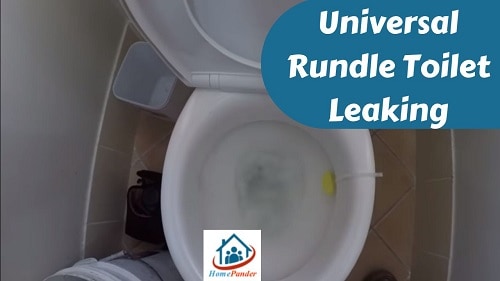

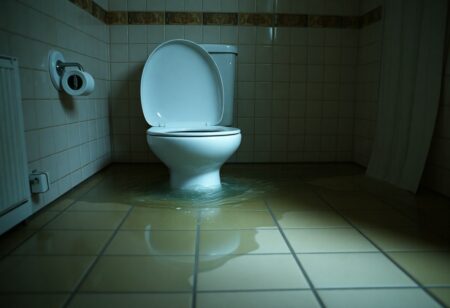
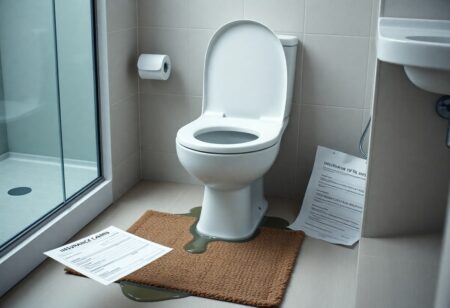


![How to Remove Crystallized Urine [Explained]](https://homepander.com/wp-content/uploads/2022/02/How-To-Remove-Crystallized-Urine.jpg)

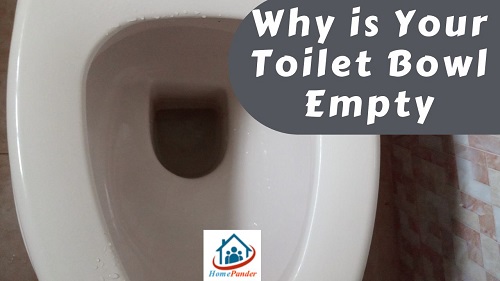

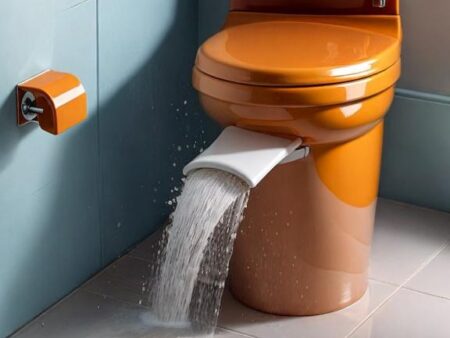

![How To Clean Dark Grout That Has Turned White [5 Easy Ways]](https://homepander.com/wp-content/uploads/2021/12/How-To-Clean-Dark-Grout-That-Has-Turned-White.webp)